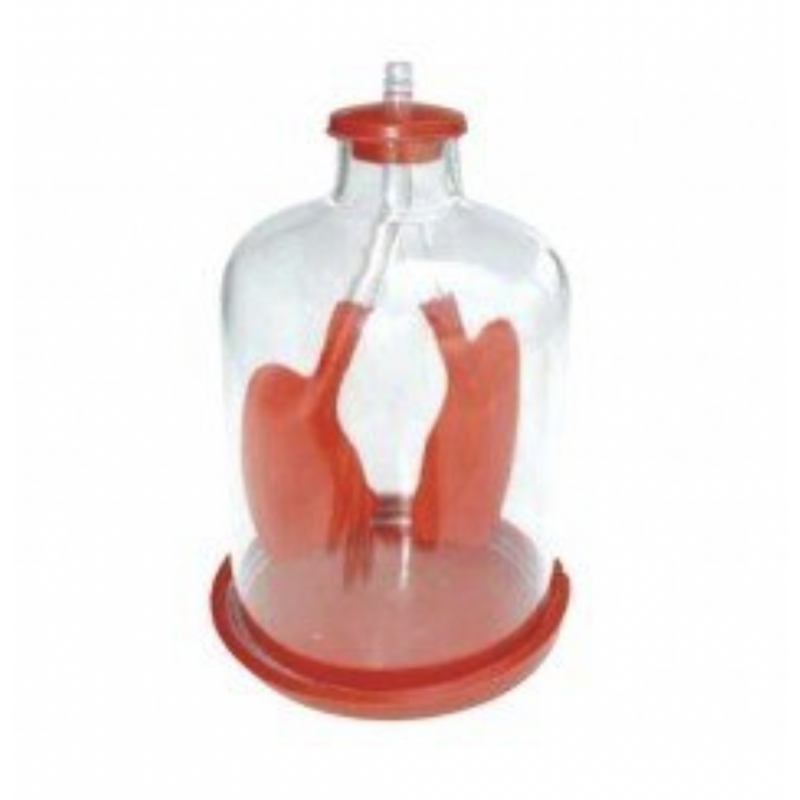

Understanding the human respiratory system isn't just about memorizing diagrams—it's about seeing it in action. The Human Lungs Demonstration Model transforms an abstract concept into a tangible, visual experience by simulating the mechanics of breathing in real time. Whether you're teaching middle school biology or guiding future nurses through physiology basics, this model helps learners of all levels grasp how lungs actually work.
Housed in a clear, durable chamber, this model contains flexible rubber lungs connected to a tracheal tube and a diaphragm base. With just a simple pull of the diaphragm membrane, users can visibly observe the inflation and deflation of the lungs—demonstrating negative pressure breathing with clarity that textbooks alone can’t match. It’s an ideal companion to any respiratory or anatomy unit, offering students an “aha” moment as they see inhalation and exhalation come to life before their eyes.
Science educators praise this model for its simplicity and impact. As one teacher put it, “I’ve never seen my students more engaged during a lesson on lungs—it makes invisible biology visible.” And that’s exactly what this tool is designed to do: create a hands-on, interactive experience that leaves a lasting impression.
This demonstration model is especially useful for:
The model is compact and easy to use, making it a great fit for mobile educators, traveling instructors, and outreach programs. No electricity or special tools are required—just a pull on the diaphragm, and the visual impact is immediate. It’s made from high-quality, durable materials designed to withstand repeated classroom handling while maintaining consistent performance.
From the basics of breathing to the fundamentals of negative pressure, the Human Lungs Demonstration Model takes a core life process and turns it into something every student can see, feel, and remember.
Breathing is automatic—but understanding how it works is anything but. The Human Lungs Demonstration Model gives students a first-hand look at the biomechanics behind every inhale and exhale. From classroom labs to professional training programs, this tool takes center stage in helping learners visualize the relationship between the diaphragm, air pressure, and lung expansion. It’s anatomy you can watch in motion—simple, smart, and incredibly effective.
At the heart of this model is a transparent dome that houses two flexible rubber lungs. These are connected to a tracheal stem and suspended from the chamber’s lid. At the bottom, a stretchable membrane represents the diaphragm. When this membrane is gently pulled downward, it simulates a real-life inhalation by increasing internal volume and reducing pressure—causing the “lungs” to expand. Releasing the membrane reverses the action, simulating exhalation.
This system perfectly demonstrates the principle of negative pressure breathing, a concept central to understanding human respiration. Unlike balloons that are inflated by force, human lungs rely on a pressure differential created by the diaphragm. This model makes that concept click for students who struggle with static illustrations or textbook definitions alone.
Educators in both general science and health sciences can integrate this tool into a wide range of lessons:
Students often learn best when they can interact with the concept—not just read about it. This model encourages questions, sparks dialogue, and creates moments of real understanding. Instructors find it especially helpful during revision sessions or concept reinforcement activities. It’s compact, durable, and ready for classroom use with zero setup—no batteries, no software, just a direct, physical demonstration of how breathing works.
As one anatomy professor noted, “This model turns breathing into something students can grasp—literally and conceptually.”
Whether you’re teaching high school biology or preparing healthcare students for patient interaction, this model offers a clear, unforgettable view of a process we all take for granted—until we see how it really works.
In science education, the best tools are the ones that turn theory into understanding—and the Human Lungs Demonstration Model does exactly that. It strips away the complexity of respiratory physiology and replaces it with a clean, tactile, and visual experience that sticks. Whether in a classroom, a clinic, or a skills lab, this model gives learners the rare opportunity to truly see how lungs work.
By simulating real breathing mechanics, this model helps bridge the gap between diagrams on a page and processes inside the body. When the diaphragm membrane is pulled, and the lungs visibly inflate, a light goes on for students: this is what happens inside their own chest—over 20,000 times a day. That realization makes the respiratory system personal, memorable, and easier to retain long after the class is over.
Its benefits go far beyond general science. For nursing and allied health students, it offers a foundational understanding that supports more advanced study in respiratory therapy, mechanical ventilation, and pulmonary assessment. For younger learners, it fosters early curiosity about the body and can be the first step in sparking interest in healthcare careers. For instructors, it’s a durable, reusable tool that makes every demo more engaging and every concept more accessible.
The model is especially valuable in today’s hybrid and hands-on learning environments. It allows educators to demonstrate physiological principles in real time, using a device that’s simple enough for beginners but powerful enough for advanced discussion. From Boyle’s Law and atmospheric pressure to the basics of gas exchange, this device acts as a springboard for layered learning and deeper inquiry.
And because it’s entirely mechanical, with no need for power or maintenance, it’s perfect for mobile teaching kits, science exhibitions, and remote demonstrations. Just pick it up, place it on a table, and begin teaching. It’s that intuitive.
As one biology teacher noted, “I’ve used dozens of models, but this one consistently delivers the biggest ‘aha’ moments. It shows, it engages, and it sticks.”
From lungs that move to minds that light up, this demonstration model does more than teach anatomy—it makes it unforgettable. It’s a smart, straightforward tool with a powerful impact, built for classrooms that don’t just inform—but inspire.
Total Reviews (1)